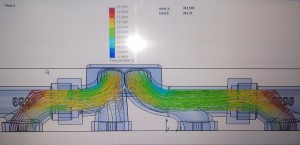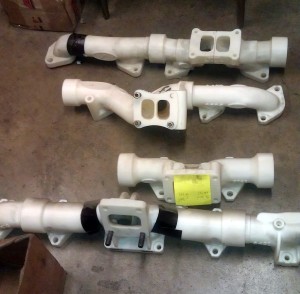 Not all exhaust manifolds are created equal. In fact, they aren’t even close. There seems to be some confusion in the industry as to which manifold is the best and where they are manufactured. I can tell you this – if it doesn’t say “Made in the USA” it’s not made here and is usually made in China. It is illegal to say “Made in the USA” if it’s not made here. So, if you have purchased an exhaust manifold that doesn’t say that, then you were taken advantage of. The rest of this article is going to tell you how we build our American-made exhaust manifolds, and it may get a little technical.
Not all exhaust manifolds are created equal. In fact, they aren’t even close. There seems to be some confusion in the industry as to which manifold is the best and where they are manufactured. I can tell you this – if it doesn’t say “Made in the USA” it’s not made here and is usually made in China. It is illegal to say “Made in the USA” if it’s not made here. So, if you have purchased an exhaust manifold that doesn’t say that, then you were taken advantage of. The rest of this article is going to tell you how we build our American-made exhaust manifolds, and it may get a little technical.
We start out by flow-testing a standard factory OEM (overseas made) manifold on a Saenz S-600 flow bench. Next, we flow-test the head, to see how much air is flowing through it, to see if the stock manifold will be sufficient. Usually, it does not have enough flow for a 500-hp engine, so we design the new manifold on a computer using a computer-animated flow bench to match the flow coming from the head. The computer allows us to simulate the cylinder pulses and measure the velocity of the exhaust (see photo). This is why our manifolds allow the turbo to respond quicker to the movement of the throttle.
Once we have established a design, we then print the exhaust manifold on a 3D printer that makes a functional part out of plastic (see photo). We then put the plastic manifold on the flow bench to confirm our findings on the computer. Now, it’s off to the foundry to make the first mold and pour the first casting. After the cast iron cools, it has to be machined and re-tested on the flow bench. Any changes that need to be made are done at this time. These “Made in the USA” manifolds are made of a high-silica moly that has the correct metal properties to ensure strength and proper elongation so the exhaust manifolds can expand and contract and still hold their shape without cracking, leakage at the joints, or breaking of the mounting bolts.
 Now the manifolds are ready for the heat-treating process, which is a process that lines up the molecules in the high-silica moly cast iron. The overseas manifolds are NOT heat-treated, and that is why they break bolts and studs. After heat-treating, the manifolds are machined and then hand-ported to guarantee the exhaust is turbulence-free. This also allows the turbo to respond quicker to the input from your right foot. Once again, the exhaust manifold is installed on the flow bench to make sure we obtain the correct velocity and 20% (or more) flow than on the stock manifold. At a 20% increase in flow, the exhaust gas temperature (EGT) will be 125 degrees lower and the fuel mileage and horsepower will increase by 5%. The final step is the ceramic coating, which is then buffed to a shine. We are the only exhaust manifold manufacturer that can make these claims. Remember to look for the “Made in the USA” logo on the center section of the manifold, because that is an important piece of information.
Now the manifolds are ready for the heat-treating process, which is a process that lines up the molecules in the high-silica moly cast iron. The overseas manifolds are NOT heat-treated, and that is why they break bolts and studs. After heat-treating, the manifolds are machined and then hand-ported to guarantee the exhaust is turbulence-free. This also allows the turbo to respond quicker to the input from your right foot. Once again, the exhaust manifold is installed on the flow bench to make sure we obtain the correct velocity and 20% (or more) flow than on the stock manifold. At a 20% increase in flow, the exhaust gas temperature (EGT) will be 125 degrees lower and the fuel mileage and horsepower will increase by 5%. The final step is the ceramic coating, which is then buffed to a shine. We are the only exhaust manifold manufacturer that can make these claims. Remember to look for the “Made in the USA” logo on the center section of the manifold, because that is an important piece of information.
After 25 manifolds have been poured, a test bar of the cast iron is poured and then the metal properties are checked. A log of all of the batches of cast iron has been kept since we made our first exhaust manifold. Nobody else in the entire world does this, but it helps us to maintain quality and consistency in our products. We are currently manufacturing manifolds for Caterpillar (3406E, C-15 and ACERT), Cummins (ISX EGR and EGR repaired), and Detroit (12.7 and 14.1 liter non-EGR and EGR) engines. For our Australian customers, we also make manifolds for Caterpillar C-13 and C-15 models (cabover only). We will also soon have manifolds available for the 1998-2002 Cummins ISX and N-14 engines.
If you don’t see your manifold on this list, we can still help you. We can take a stock manifold, hand port it, flow test it, ceramic coat it, and then buff it to a shine. This custom-modified manifold will flow 20% more exhaust and will also lower the EGT by 125 degrees. On the MBE 4000 Mercedes engine, a 50 horsepower gain will also be realized (most others gain about 35 hp).
When calling to check availability and/or price, be sure to have the CENTER SECTION CASTING NUMBER of your stock manifold on-hand. This is the only foolproof way of making sure that we send you the correct manifold to hold your turbocharger at the proper angle that permits it to fit under your hood. If you can’t find it, you can call your truck dealership or engine manufacturer and give them your VIN number or engine serial number – with that information, they can tell you your CENTER SECTION CASTING NUMBER (which is usually a 7 or 8 digit number). If you have any comments or questions, contact me at Pittsburgh Power in Saxonburg, PA by calling (724) 360-4080 or via e-mail at bruce@pittsburghpower.com.

6 Comments
I have an ‘O4 Columbia with the MBE 4000. I was thinking of making some upgrades. How much does your exhaust manifold cost.
Hello Jon, Yes we can build a manifold for you, we will need the part number of your manifold and allow 4 weeks to produce it. The price is around $1385.00 That price will stand if Mercedes did not take a price increase this year.
Hi:
We need to make 04 exhaust manifold N/P: 336-7595 of the engine C18 N/S: RHX10737, of the truck 772 N/S: RLB00678.
Can EGT make these pieces with the material Ceramic Coated cooling?.
The temperature of the gases of leak reaches to them 800°C.
Thank you for his response
Hi I’m looking for an exhaust manifold for a 1988 john Deere 4239 Diesel engine. I’m wanting to put a turbo on it for street applications. Using engine in a 97 Jeep Wrangler. Any info or hints would be greatly appreciated. Thanks kevo
Have 2009 mb4000 everything been deleted love to have 50 more horses.I belive a intake would be the simplest.
Old Td-25c engine is dti-817c can’t find the middle peace of the exhaust manifold anywhere help me out lol